This simply seasoned rib roast recipe makes a tender beef dish that stands out. Pair it with homemade horseradish sauce and you’ll be in tastebud heaven!
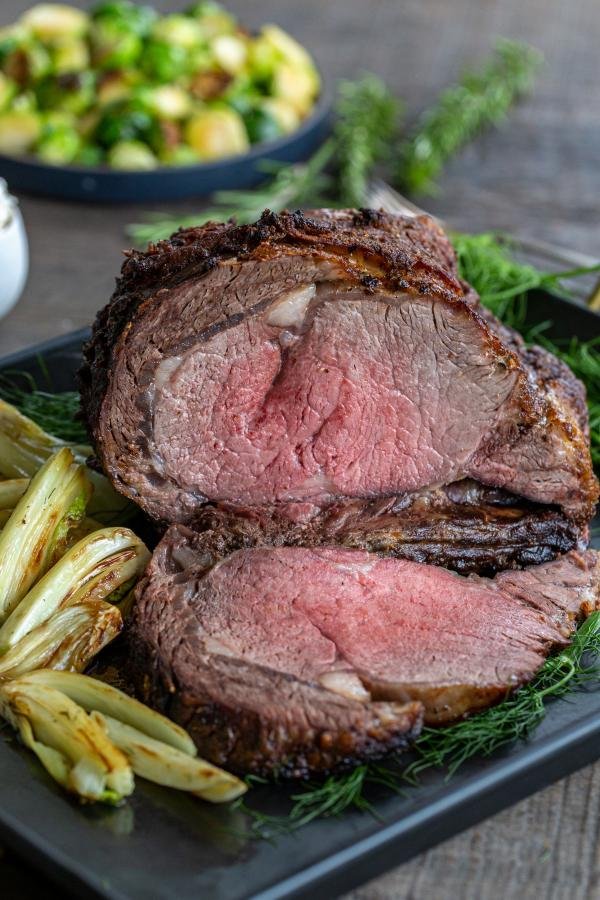
What Is Rib Roast?
Rib roast (when referred to the cut of beef) is a cut that comes from the side of the cow, between the chuck and short loin (the space that holds the ribs). It is savory, finely textured, and is generously marbled. The rib roast section is fairly large, so it can be cut into “sub-sections”, which are often called the prime rib, standing rib roast, ribeye roast, and/or holiday roast. The rib roast is actually where ribeye steaks come from!
When talking about this rib roast recipe (the entrée), it is a generously seasoned cut of beef that is cooked slowly in the oven. The result is a tender, juicy, and flavorful protein dish that is easy enough for an everyday meal, yet fancy enough for holidays and celebrations.
Hot tip: Have you ever been confused by beef “grades”? The grade tells you about the meat’s potential tenderness and juiciness. If you’re looking to splurge in cost and flavor, buy “USDA prime grade.” For a slightly cheaper option, go with the “select” grade, and for the best of both worlds, choose the “choice” grade.
Rib Roast Video
How To Make Rib Roast & Horseradish Sauce
In case you’re not already drooling, you certainly will be after checking out how easy and quick it is to get this meat on your table. And — the horseradish sauce for the prime rib is a must! The steps may be crazy easy, but this will be one fancy meal.
Making the Rib Roast
- Prepare the rub: Combine the oil, garlic, and mixed ground peppercorns (white, green, pink, and black pepper) in a small bowl. Preheat the oven to 350°F.
- Rub the beef generously: First, generously salt the roast all over. Then, press the rub into all sides of the roast.
- Roast the beef: Place the roast fat side up into a baking dish or on the rack of a roasting pan. Roast for about 2.5 hours, or until it reaches your preferred doneness when checked with a meat thermometer.
- Allow the roast to rest: Once done cooking, cover the roast with foil and allow it to rest on the counter for at least 15 minutes. Serve with your favorite sides and horseradish sauce.
Hot tip: To carve a bone-in roast, turn it on its side and remove the ribs. Hold the roast steady by grasping a piece of rib bone that is sticking out. Using a sharp knife, follow the curvature of the rib bones as closely as possible. Now that it is boneless, start carving the meat from one of the ends into ½ inch thick slices, going across the grain for maximum tenderness.
Making the Horseradish Sauce
- Prepare the ingredients: Before making the sauce, peel and grate the horseradish, finely dice the fennel bulb, and chop the fresh fennel fronds.
- Whisk the sauce together: Whisk the whipping cream until soft peaks form. Then, add in the horseradish, fennel bulb, and fennel fronds. Season to taste with salt.
- Refrigerate: Refrigerate until ready to serve.
Approximate Prime Rib Roast Cooking Times
In case you’re wondering how long to cook your rib roast, take a look at this quick cheat sheet to plan your evening! Whether you have a bone-in or boneless cut, always cook at 350°F. For medium rare doneness, the internal temperature should reach 135°F, while for medium doneness it should be 145°F.
Bone-in Cooking Times
- 4-6 Pounds (two ribs): 1 ¾ – 2 ¼ hours for medium rare or 2 ¼ – 2 ¾ hours for medium.
- 6-8 Pounds (two to four ribs): 2 ¼ – 2 ½ hours for medium rare or 2 ½ – 3 hours for medium.
- 8-10 Pounds (four to five ribs): 2 ½ – 3 hours for medium rare or 3 – 3 ½ hours for medium.
Boneless Cooking Times
- 3-4 Pounds: 1 ½ – 2 hours for medium rare or 2 – 2 ¼ hours for medium.
- 4-6 Pounds: 2 – 2 ¼ hours for medium rare or 2 ¼ – 2 1/2 hours for medium.
- 6-8 Pounds: 2 ¼ – 2 ½ hours for medium rare or 2 ½ – 2 ¾ hours for medium.
Hot tip: Use a thermometer to take the guesswork out of gauging doneness. Use an oven-safe meat thermometer to avoid opening the oven unnecessarily and losing juices by repetitively poking the meat for doneness. However, if all you have is an instant-read thermometer, it will still work wonderfully.
Tips for Making the Perfect Prime Rib Roast
As festive and impressive rib roast is, it’s surprisingly simple to make. Follow these eight tips to make sure your roast takes front and center of your lunch and/or dinner table.
- Opt for bone-in prime rib: We prefer bone-in prime rib/ribeye roast because the bone insulates the meat as it cooks and produces more flavorful and tender results. However, boneless is the ideal choice for those who want to take a shortcut from carving the meat.
- Plan out the portion sizes: As a general rule of thumb, plan for one rib for every two people. For example, an 8-10 pound bone-in prime rib roast has about 4-5 ribs and serves 8-10 people or more. On the flip side, a 4-6 pound bone-in prime rib roast has two 2 ribs and serves 4-6 people.
- Season the roast generously: Season the roast well to ensure the flavor is up to par. The more, the merrier! Add your favorite herbs like rosemary, dill, or thyme for more herby flavor.
- Allow the roast to come to room temperature before cooking: A cold roast takes longer to cook, so take the meat out of the refrigerator about an hour before cooking. Feel free to season it while it is still cold to allow the flavor to permeate in.
- Roast with the fat side up: The best way to roast prime rib is with the fat cap still on and fat side up. This keeps the beef from drying out while cooking.
- Avoid covering the roast: The only time to cover the roast in the oven is if the outside crust is getting too dark while the inside is still cooking. Otherwise, leave it uncovered for maximum crisp.
- Cook to your desired doneness: We prefer to cook rib roast to about medium-rare or medium doneness, but if you prefer more well done meat, keep it in the oven longer. Be aware the meat will be a little drier if cooked longer. Also, while the beef rests under an aluminum foil tent, it tends to cook an additional 10-15 degrees. Take this into account when determining your desired doneness.
- Tent the roast after removing from the oven: Tent the meat with aluminum foil and allow it to rest for at least 15 minutes after cooking. It locks in the delicious juices!
What To Serve With Prime Rib Roast
Your beautifully cooked prime rib roast is guaranteed to shine as the star of dinner. Now — what about the side dishes? Our favorites are buttery and creamy mashed potatoes and vinegar-y marinated mushrooms. For a deluxe side, try these beautiful duchess potatoes. As a veggie option, greens beans or bacon brussels sprouts are a classic pairing. Or make a beet and goat cheese arugula salad for fresh flavor spin! Lastly, don’t forget about the deviled eggs– essential for any holiday spread!
Storage & Reheating
Depending on how large your cooked roast is, you may have a little or a lot of leftovers. Either way — we’ve got you covered with the best ways to keep your roast tasting fresh even after a few days.
- Refrigerator: To store for up to four days, place the cooled roast into an airtight container and refrigerate. Or, for an even better result, wrap it tightly in plastic wrap so all the juices stay sealed in and don’t slowly build up in the bottom of the container.
- Freezer: To freeze for up to six months, it is best to vacuum seal the roast in order to prevent freezer burn. We love this vacuum sealer. To thaw, place in the refrigerator overnight.
- Reheat: To reheat cooked roast, warm the oven to 250°F, then add the sliced rib roast to a small pan. Pour in a few tablespoons of broth or water to add extra moisture to the roast. Cover with foil, then warm until the slices have heated through. For a fast reheat, the microwave is a good choice — however, the slices may turn out a bit more rubbery.
More Roast Recipes
- Slow Cooker Beef Roast — A great way to use up tougher cuts of beef
- Best Pork Roast Recipe — Tender and delicious in sandwiches, tacos, and more!
- Pressure Cooker Pot Roast — Ready in 1.5 hours but tastes slow-cooked for longer
- Roast Beef Tenderloin — The most tender cut of beef made extremely flavorful
Recipe
Ingredients
Rib Roast
- 6 lb Ribeye Roast Bone-In
- 3 tbsp salt
- 2 tbsp coarsely ground mixed peppercorns (black, white, green and pink)
- 1 tbsp minced garlic
- 2 tbsp vegetable oil
Horseradish Sauce
- 1/2 cup whipping cream
- 3 tbsp finely chopped fresh fennel bulb
- 3 tbsp finely grated fresh horseradish
- 1 tbsp finely chopped fresh fennel fronds
- 1/8 tsp salt
Instructions
Making Rib Roast
- Heat the oven to 350 °F. Prepare the ingredients for the roast rub by combining the oil, garlic, and pepper together in a bowl.
- Rub the beef roast generously with salt on all sides. Press the seasonings evenly into the roast.
- Place the beef roast in a baking dish or pan with the fat side up. Insert an ovenproof meat thermometer into the thickest part of the beef, making sure it's not touching the bone. Roast for about 2 1/2 hours (refer to doneness temperature in blog post notes above.)
- Once the roast is removed from the oven, lightly cover it with foil and let it rest for at least 15 minutes. Serve it with your favorite sides.
Horseradish Sauce
- Prepare the ingredients for the horseradish sauce. Peel and grate the horseradish, finely dice the fennel bulb, and chop fresh fennel fronds.
- Whisk the whipping cream until you get soft peaks. Add in the horseradish, fennel bulb, and fennel fronds. Season with salt.
- Place the sauce in the refrigerator until ready to serve.

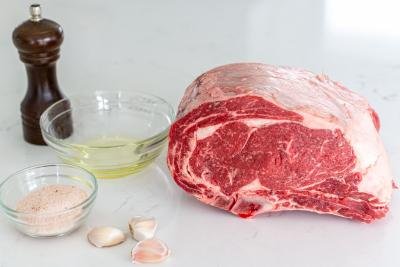
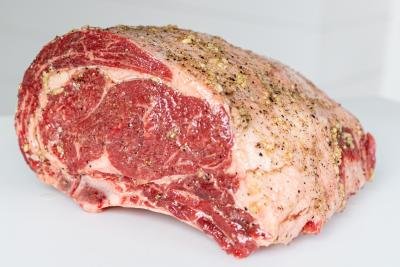
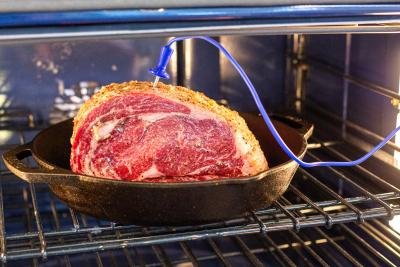
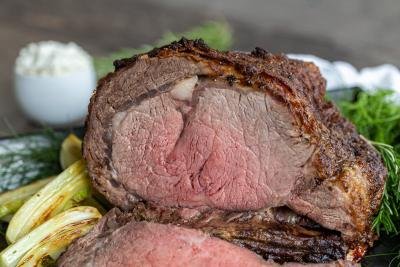

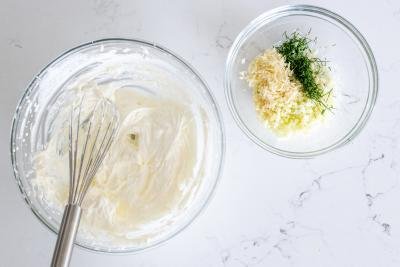
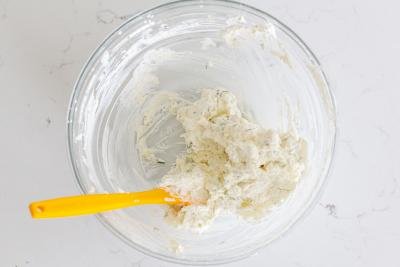
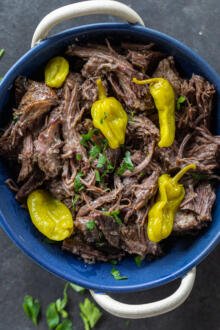
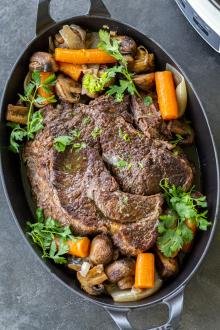
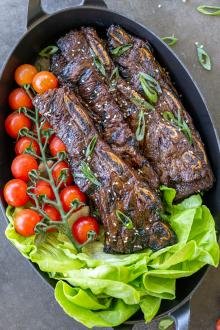
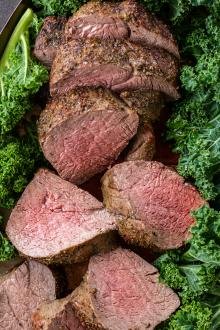


Hi Natalya! I made this recipe today. I didnt make the horseradish sauce because I was short on time. Marinade was great and it came out perfect!!!.
Recipe is a keeper!!!
Hi Lena, I am so delighted to hear that! Thank you so much for your feedback. Enjoy!
Awful method. Look at all the grey bands around it. Putting it in a 350 degree oven overcoooks the outside before the inside can each temp.
The secret is to cook the roast at 220 until it reaches temp (around 120 max), rest it, and then put with back in into a 550 degree oven for ten minutes.
Google reverse sear. You're welcome.
Hey El, thank you for sharing your feedback. I appreciate you taking the time to share your method. We worked with a chef on this recipe, it was delicious!
I am so happy to find this recipe. I would love to serve prime rib on Christmas eve. This makes is sound easy.
Laura, I am so glad you found it! You will love this recipe.
So delicious and super easy dinner idea.
Yes, and it can easily be dressed to look so fancy. 🙂 Thank you Becky!
I know what I will be preparing for Christmas dinner; this looks amazing! Can't wait to impress my family with this!
Sara, thank you! I am so honored that this recipe will make it to your Christmas dinner!
Looks so Yummy. We got a new grill with a rotisserie and I’ve been experimenting with lamb and pork roasts for few Thanksgiving family gatherings. I’ll try your recipe for upcoming holidays, hopefully it turns out good.
Hi Yelena, that grill sounds really neat. I think you will love this recipe. It comes out beautiful and the flavors are wow!